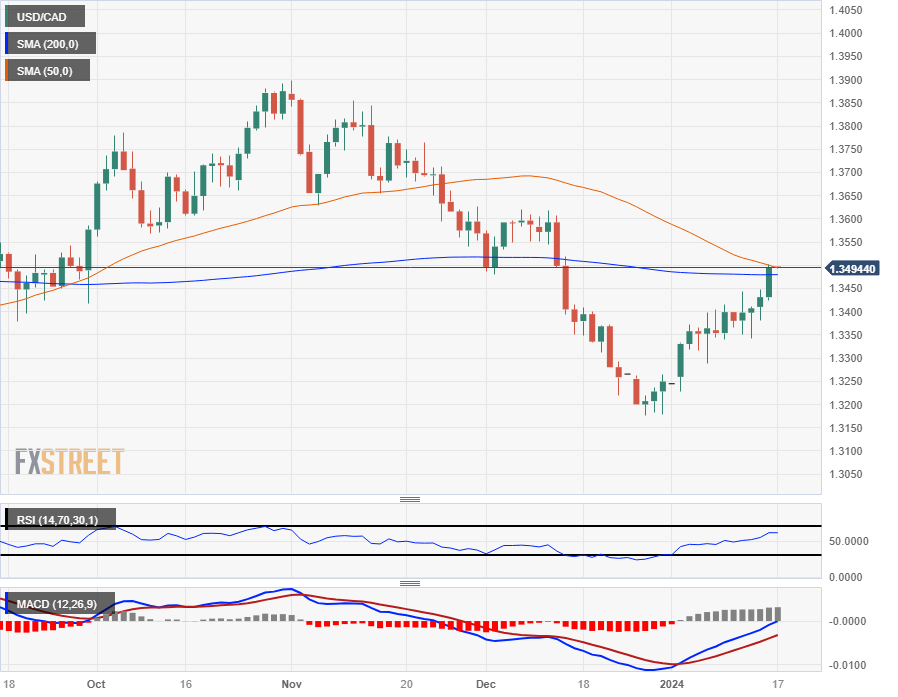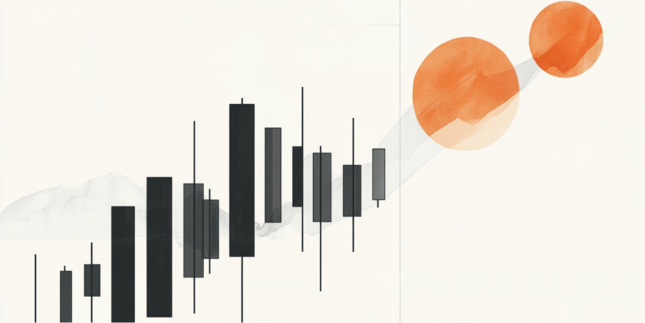Most recent article: Canadian Dollar chalks in further losses against Greenback on Wednesday
- The Canadian Dollar gave up further ground to the US Dollar despite a broad recovery.
- Canadian CPI inflation printed mostly as expected, market bets of a BoC rate cut eased.
- Crude Oil roils again as geopolitical concerns weigh on fossil fuel market flows.
The Canadian Dollar (CAD) climbed against most of its currency trading peers on Tuesday, but fell back against the US Dollar (USD), which took top spot as the best-performing major currency.
Canada’s Consumer Price Index (CPI) inflation in December mostly came in at expectation, but a lack of price growth easing has trimmed market bets of a March rate cut from the Bank of Canada (BoC).
Daily digest market movers: Canadian inflation hits forecasts, but gives little else for rate cut hopes
- Canadian MoM CPI inflation in December printed as expected as -0.3% versus November’s 0.1%.
- Annualized Canadian CPI rose, printed at market forecasts of 3.4% for the year through December compared to the previous period’s 3.1%.
- Canadian money markets now see a 34% chance of a BoC rate cut in March, down from 46% pre-CPI inflation print.
- Canadian annualized Housing Starts rose to 249.3K for the year through December, over the previous 210.9K (revised from 212.6K), beating the forecast of 243K.
- Federal Reserve (Fed) officials continue to talk down market bets of rate cuts, Fed Governor Christopher Waller notes that inflation needs to be on a gradual pace to 2%.
- Fed's Waller: Near-term data allows Fed to discuss policy cuts in 2024
- Crude Oil markets continue to churn on geopolitical factors surrounding Houthi attacks targeting civilian cargo ships through the Red Sea.
Canadian Dollar price today
The table below shows the percentage change of Canadian Dollar (CAD) against listed major currencies today. Canadian Dollar was the strongest against the Australian Dollar.
| USD | EUR | GBP | CAD | AUD | JPY | NZD | CHF | |
| USD | 0.64% | 0.62% | 0.43% | 1.00% | 0.95% | 0.84% | 0.66% | |
| EUR | -0.64% | -0.01% | -0.20% | 0.36% | 0.32% | 0.21% | 0.02% | |
| GBP | -0.63% | 0.01% | -0.20% | 0.37% | 0.32% | 0.20% | 0.02% | |
| CAD | -0.44% | 0.20% | 0.19% | 0.56% | 0.51% | 0.40% | 0.22% | |
| AUD | -1.01% | -0.36% | -0.37% | -0.58% | -0.04% | -0.15% | -0.33% | |
| JPY | -0.97% | -0.33% | -0.35% | -0.54% | 0.03% | -0.12% | -0.31% | |
| NZD | -0.84% | -0.19% | -0.21% | -0.41% | 0.16% | 0.10% | -0.19% | |
| CHF | -0.66% | -0.02% | -0.02% | -0.23% | 0.34% | 0.29% | 0.18% |
The heat map shows percentage changes of major currencies against each other. The base currency is picked from the left column, while the quote currency is picked from the top row. For example, if you pick the Euro from the left column and move along the horizontal line to the Japanese Yen, the percentage change displayed in the box will represent EUR (base)/JPY (quote).
Technical Analysis: Canadian Dollar broadly gains but recedes against Greenback
The Canadian Dollar (CAD) is down around a four-tenths of a percent against the US Dollar on Tuesday but is climbing against the rest of its major currency peers. The Canadian Dollar gained around half a percent against the Japanese Yen (JPY) and the Australian Dollar (AUD), while climbing around four-tenths of a percent against the New Zealand Dollar (NZD) and a fifth of a percent against the Euro (EUR).
The USD/CAD rose back into the 1.3500 handle for the first time since mid-December as the US Dollar gained against the Loonie, dragging the pair higher after last week’s late bounce from the 200-hour Simple Moving Average (SMA) near 1.3350.
Daily candlesticks have the USD/CAD climbing directly into the 200-day SMA, and continued bullish momentum faces a technical quagmire with the 50-day SMA descending into 1.3500 and set for a bearish cross of the long-term moving average.
Continued bidding pressure will have the pair set for a fresh challenge of November’s peak near 1.3900, while the technical floor sits at December’s swing low into 1.3200.
USD/CAD Hourly Chart
USD/CAD Daily Chart
Canadian Dollar FAQs
What key factors drive the Canadian Dollar?
The key factors driving the Canadian Dollar (CAD) are the level of interest rates set by the Bank of Canada (BoC), the price of Oil, Canada’s largest export, the health of its economy, inflation and the Trade Balance, which is the difference between the value of Canada’s exports versus its imports. Other factors include market sentiment – whether investors are taking on more risky assets (risk-on) or seeking safe-havens (risk-off) – with risk-on being CAD-positive. As its largest trading partner, the health of the US economy is also a key factor influencing the Canadian Dollar.
How do the decisions of the Bank of Canada impact the Canadian Dollar?
The Bank of Canada (BoC) has a significant influence on the Canadian Dollar by setting the level of interest rates that banks can lend to one another. This influences the level of interest rates for everyone. The main goal of the BoC is to maintain inflation at 1-3% by adjusting interest rates up or down. Relatively higher interest rates tend to be positive for the CAD. The Bank of Canada can also use quantitative easing and tightening to influence credit conditions, with the former CAD-negative and the latter CAD-positive.
How does the price of Oil impact the Canadian Dollar?
The price of Oil is a key factor impacting the value of the Canadian Dollar. Petroleum is Canada’s biggest export, so Oil price tends to have an immediate impact on the CAD value. Generally, if Oil price rises CAD also goes up, as aggregate demand for the currency increases. The opposite is the case if the price of Oil falls. Higher Oil prices also tend to result in a greater likelihood of a positive Trade Balance, which is also supportive of the CAD.
How does inflation data impact the value of the Canadian Dollar?
While inflation had always traditionally been thought of as a negative factor for a currency since it lowers the value of money, the opposite has actually been the case in modern times with the relaxation of cross-border capital controls. Higher inflation tends to lead central banks to put up interest rates which attracts more capital inflows from global investors seeking a lucrative place to keep their money. This increases demand for the local currency, which in Canada’s case is the Canadian Dollar.
How does economic data influence the value of the Canadian Dollar?
Macroeconomic data releases gauge the health of the economy and can have an impact on the Canadian Dollar. Indicators such as GDP, Manufacturing and Services PMIs, employment, and consumer sentiment surveys can all influence the direction of the CAD. A strong economy is good for the Canadian Dollar. Not only does it attract more foreign investment but it may encourage the Bank of Canada to put up interest rates, leading to a stronger currency. If economic data is weak, however, the CAD is likely to fall.
Information on these pages contains forward-looking statements that involve risks and uncertainties. Markets and instruments profiled on this page are for informational purposes only and should not in any way come across as a recommendation to buy or sell in these assets. You should do your own thorough research before making any investment decisions. FXStreet does not in any way guarantee that this information is free from mistakes, errors, or material misstatements. It also does not guarantee that this information is of a timely nature. Investing in Open Markets involves a great deal of risk, including the loss of all or a portion of your investment, as well as emotional distress. All risks, losses and costs associated with investing, including total loss of principal, are your responsibility. The views and opinions expressed in this article are those of the authors and do not necessarily reflect the official policy or position of FXStreet nor its advertisers. The author will not be held responsible for information that is found at the end of links posted on this page.
If not otherwise explicitly mentioned in the body of the article, at the time of writing, the author has no position in any stock mentioned in this article and no business relationship with any company mentioned. The author has not received compensation for writing this article, other than from FXStreet.
FXStreet and the author do not provide personalized recommendations. The author makes no representations as to the accuracy, completeness, or suitability of this information. FXStreet and the author will not be liable for any errors, omissions or any losses, injuries or damages arising from this information and its display or use. Errors and omissions excepted.
The author and FXStreet are not registered investment advisors and nothing in this article is intended to be investment advice.
Recommended content
Editors’ Picks

EUR/USD challenges 1.0500 on Dollar's bounce
The US Dollar now picks up further pace and weighs on the risk-associated assets, sending EUR/USD to the boundaries of the key 1.0500 region and at shouting distance from its 2024 lows.

GBP/USD remains weak and puts 1.2600 to the test
GBP/USD remains on the back foot and now approaches the key support at 1.2600 the figure in response to the resurgence of the bid bias in the Greenback.

Gold extends gains beyond $2,660 amid rising geopolitical risks
Gold extends its bullish momentum further above $2,660 on Thursday. XAU/USD rises for the fourth straight day, sponsored by geopolitical risks stemming from the worsening Russia-Ukraine war. Markets await comments from Fed policymakers.

BTC hits an all-time high above $97,850, inches away from the $100K mark
Bitcoin hit a new all-time high of $97,852 on Thursday, and the technical outlook suggests a possible continuation of the rally to $100,000. BTC futures have surged past the $100,000 price mark on Deribit, and Lookonchain data shows whales are accumulating.

A new horizon: The economic outlook in a new leadership and policy era
The economic aftershocks of the COVID pandemic, which have dominated the economic landscape over the past few years, are steadily dissipating. These pandemic-induced economic effects are set to be largely supplanted by economic policy changes that are on the horizon in the United States.

Best Forex Brokers with Low Spreads
VERIFIED Low spreads are crucial for reducing trading costs. Explore top Forex brokers offering competitive spreads and high leverage. Compare options for EUR/USD, GBP/USD, USD/JPY, and Gold.